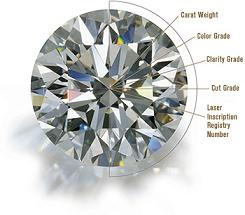The Four Cs or Diamond Criteria Explained
 Knowing the four Cs is crucial. Not only the diamond's price is fully dependent on them, but if you, by chance, are planning to purchase stones online, you can get a good grasp of how they will look like when shipped just by looking at the balance of the four Cs. In this page, we are going to look into the qualities of diamonds. We'll also discover which quality is considered the most important and why and many other fun facts about the marvelous gems we call diamonds.
Knowing the four Cs is crucial. Not only the diamond's price is fully dependent on them, but if you, by chance, are planning to purchase stones online, you can get a good grasp of how they will look like when shipped just by looking at the balance of the four Cs. In this page, we are going to look into the qualities of diamonds. We'll also discover which quality is considered the most important and why and many other fun facts about the marvelous gems we call diamonds.
The first of the four Cs stands for carat. A carat equals 200 milligrams or 0.2 grams; stones below one carat are usually weighed in points from 0 to 100 where a point is one-hundredth of a carat or 2mg, but 100 points are one carat. Although the carat is a fixed value, the price varies a lot, depending on the other three Cs of the gem, and the demand for the exact weight. For example, a 0.99 carat stone can be significantly cheaper than that of one carat. Hence this, it is even advisable to avoid one carat stones, because they are oftentimes cut to meet the demanded weight, not for top-notch quality.
Clarity is the second C. The level of clarity is determined by the visibility of internal defects, called inclusions. Due to the fact that diamonds come from the heart of the earth and are put under very high pressure when they're born, very few diamonds are without inclusions. Clarity is graded from FL to I3 by the Gemological Institute of America, where FL is a flawlessly clear diamond with no internal blemishes, but I3 is included or unclear stone. However, unless the clarity is graded below VS, the inclusions are usually invisible to the naked eye.
Color is the third C and this one is pretty controversial. Although diamonds are pictured to have no color, colorless diamonds are rare, thus very rare and valuable. But there is a side note that makes diamond color interesting. 'Fancy colored' diamonds are as rare -or even more so- than colorless diamonds, so, for example, a pale pink diamond, although it cannot be evaluated by the GIA scale, can and does have a lot of value. Color in diamonds is most commonly added by a small portion of nitrogen atoms replacing carbon atoms in the diamond; the color is graded from "D" to "Z", where "D" is colorless but "Z" is a bright yellow diamond; "F-J" diamonds are considered near-colorless and the color difference from a colorless diamond might be invisible unless magnified.
The last C is the most important one, because the Cut of a diamond determines the most; both in terms of value and in looks. An excellent cut diamond can look a diamond of lesser grade color look splendid; in short, it can hide the diamond's flaws, besides the obvious fact that the cut accounts for the stone's shape and most of the diamond's brilliance. The diamond's Cut is graded from Excellent, Very Good, Good to Fair and Poor. Gradation of diamonds was started by the GIA since 2006, based on careful observations of around 20,000 diamonds. This is highly controversial, because of the fact that there are countless 'standards' in which a diamond can be cut. Nevertheless, the GIA evaluation saves a lot of customers from buying rings with poor cuts - and that ultimately means poor stones.
